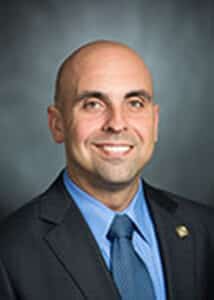Efforts by local lawmakers to pave the way for the region’s first public law school are underway.

State Rep. Armando “Mando” Martinez, D-Weslaco, will present a bill to the state’s House of Representatives this legislative session which will allow any public university system to plant a law school in the region — currently referred to as the Rio Grande Valley School of Law.
“I believe that success comes from opportunity, and I believe this would give an opportunity to a lot of our bright students who would not have to leave to seek an additional degree in law,” said Martinez, who drafted and filed the bill, House Bill 695.
The legislation would permit any public university system to sow a law school in either Hidalgo or Cameron counties. State funding for the operations and maintenance of the school would begin 2027.
This will not be the first time state representatives will be hearing a proposal of this nature. Martinez proposed a local law school in the last legislative session in 2019, House Bill 103, which garnered the support of 107 state representatives who approved the bill while 36 opposed.
However, the legislative session ended before HB 103 made it to the Senate floor and dissipated. After a few minor logistic changes, Martinez renamed it HB 695 for the current session.
In 2019, state Rep. Dade Phelan, R-Beaumont, who is presiding as speaker of the House, supported the bill — one of the several reasons Martinez is optimistic about HB 695 making it through the House and Senate this time around.
Martinez said there is “great need” for a law school in the Valley, not only to bring opportunities for local students, but encourage them to stay and practice in the region.
He noted that the attorney-to-residents ratio is more than double the state average. In Texas, according to the State Bar of Texas Department of Research & Analysis, there is an attorney for about every 311 residents. In the McAllen-Edinburg-Mission area, the ratio is one for every 805 residents.
For the Brownsville-Harlingen area, there is an attorney for every 736 residents.
“Not only do we want to provide opportunities for students, but we also want to provide the ability for people to seek legal advice and shorten that disparity,” Martinez said.
McAllen Municipal Judge Lauren Sepulveda shared the same sentiment.
“We come from a community that is historically underserved,” she said. “A lot of our people don’t have access to lawyers and this is something that can be good — not only to keep talented people home and help them practice law, but it will give a chance for more pro bono work to be done here and so people can have better access to lawyers.”
Sepulveda, who has been practicing law in the Valley for a decade and serves as the Texas Young Lawyers Association chairwoman, said the greatest value of having a local law school would be getting law students familiar with the work done by lawyers in the border region.
“Especially in these last couple of years, we have kind of had some very unique issues that I think a lot of the areas around the state don’t see,” she said, listing immigration matters, land conflicts regarding border wall construction, and criminal justice reform.
Sepulveda studied law at Baylor University in Waco, and said if it were not for the economic crisis which began in 2008 bringing her back to the Valley, she would be practicing in central Texas.
“I think that anything that would bring even more expertise in the legal field to this area can only be a good thing for the general public,” she said. “We want to keep kids that want to be lawyers that are from the Valley in the Valley.”
There are currently five public universities in the state with a law school, and four private institutions — the closest one being St. Mary’s School of Law in San Antonio.
Veronica Gonzalez, the vice president of the University of Texas Rio Grande Valley’s governmental and community relations, will be considering grafting a law school to the institution.
“We definitely have interest in exploring any expansion of any educational opportunities,” she said.
However, Gonzalez said she believes a feasibility study should be conducted to measure student demand of a local law school and assess available resources.
“If we were to do it, for instance, we would want to make sure it was a top-notch law school,” she said. “We don’t want anything that is not going to be accredited.”
Gonzalez explained that the university has been focused on nurturing UTRGV’s relatively new School of Medicine, which was established in 2014 and is currently in its accreditation process.
Though UTRGV is looking into a Valley school of law, Gonzalez said the university is working to pace its growth to ensure “it is going to be of great quality because our students here deserve the best and they deserve what students might have anywhere else across the state.”
UTRGV currently offers the Law School Preparation Institute, LSPI, an intense summer program focused on preparing students for law school. Through the program, students receive assistance preparing applications and receive several types of training, such as legal writing courses.
A maximum of 25 students are selected for the annual program, and the admission rate for students to their first choice of law school is about 90%, according to Gonzalez.




